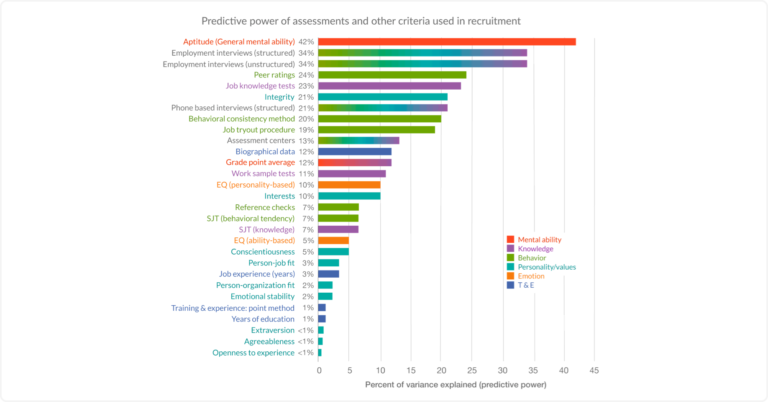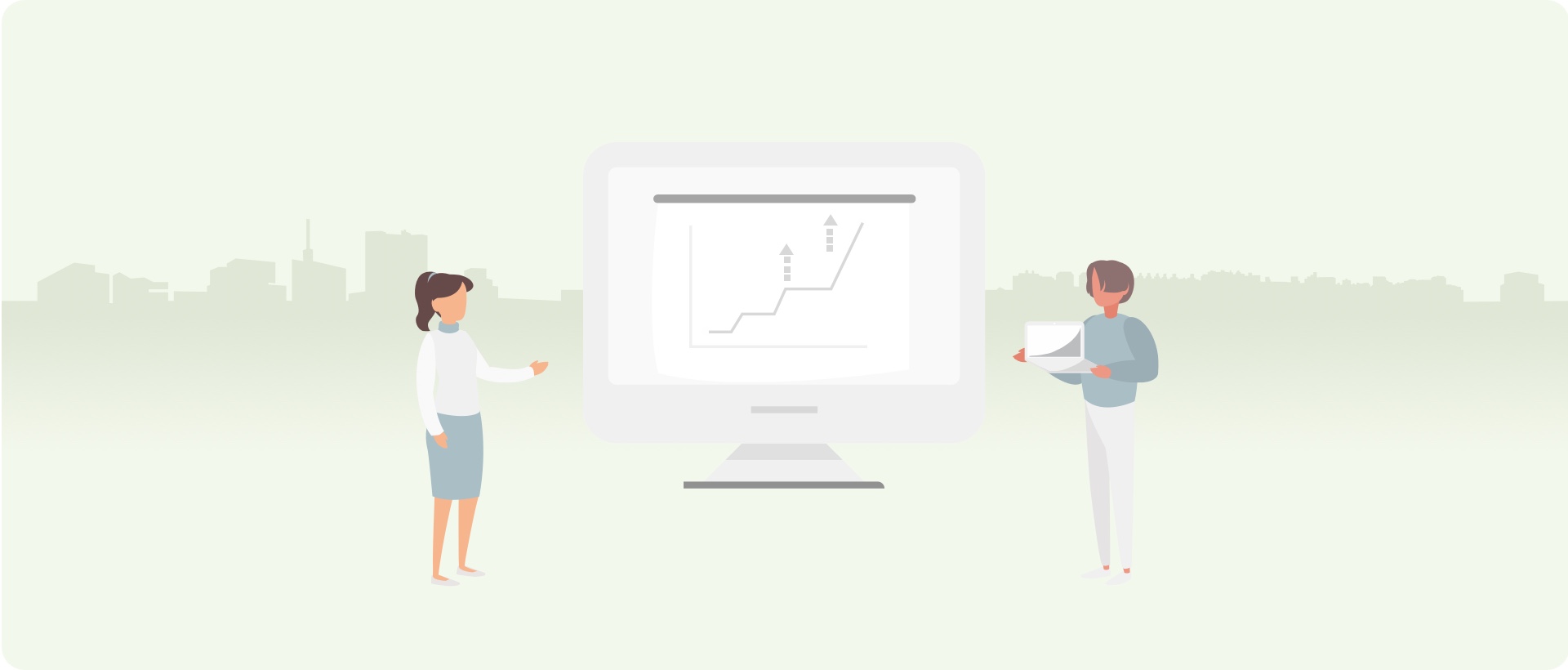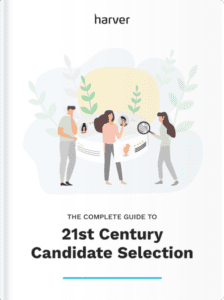As long as we humans have been walking around on this planet we call the Earth, we’ve been obsessed with the possibility of predicting the future.
The ancient Greeks had their Oracle of Delphi to consult about important political and war decisions. And throughout the Middle Ages, fortune-telling and divination were extremely popular.
That innate desire to know the future is still present today.
However, the methods to predict it are becoming more and more scientific (fortunately). Rather than reading the future in coffee grounds or tea leaves, predictions are based on various data sources.
As such, we can now forecast the weather (more or less accurately), predict natural disasters and population growth, and much more.
And yes, we can also predict hiring success.
We want to know how successful candidates will be in their role and this is where predictive hiring comes into play.
Learn all about predictive hiring in Recruitment On The Go on Soundcloud and iTunes!
|
A quick overview
- Resumes are not predictive for success
- Increasing quality of hire
- Hiring faster/ Decreasing time to hire
- More consistent hiring decisions
- Increasing candidate engagement / Boosting candidate experience
- You need to understand how predictive analytics works
- You need reliable and consistent data input
- You need to invest in the right technology stack
- You need to look at predictive hiring as a way to guide you
Like what you see?
Don’t miss out. Subscribe to our quarterly digest to get the latest TA and TM resources delivered right to your inbox.
What is predictive hiring?
Put simply, predictive analytics for hiring uses historical data to make predictions about the future. The technology detects patterns among current employees through a combination of data and assessment science.
Traditional hiring practices often still rely on (very) brief resume screenings and intuition-based interviews. Predictive hiring, however, relies on rich sets of data and smart algorithms to recommend best-fit candidates to recruiters and hiring managers.

50%
That’s the change of making an accurate hiring decision based on resume and interview alone.
Source: Psychpress.com.au
Now, about this data.
Depending on what it is you want to know, you collect data from multiple sources. A data source can be anything. If you measure the number of productive hours per employee, for example, that’s a data source.
As a general rule of thumb, the more data sources you use, the better your predictions. That is if your sources are correct, of course.
After all the relevant data is collected, it’s time to pre-process. This means that the data is cleaned, formatted, sampled and what not so that it’s ready to be used in a predictive model.
Next up, choosing a predictive model. There are many different ones, each with different outcomes – decision trees, random forests, neural networks, and more. Your go-to Data Analytics expert will be able to tell you all about them (and know which one to use when).
Once a predictive model is chosen it needs to be trained in order for the model/algorithm to be able to make predictions. In other words: the model goes for a test drive with a big chunk of data.
An example: After 20,000 candidates (the training data), 78% of them is still with the company after 6 months. This means you can say with a high degree of certainty that out of the next 1,000 candidates, around 780 will still be in service after 6 months.
Why use predictive hiring?
Well, how much time do you have? Because jokes aside, there are numerous reasons to use predictive hiring in your recruitment process. Here are 5 of them.
1. Resumes are not predictive for success
Resumes have been criticized as a way to preselect candidates for a while now. What are the most common objections against the resume in the preselection process?
- It creates bias.
As soon as a recruiter or hiring manager sees a candidate’s name, the city they live in and the school or university they went to, they’ll have an opinion about them.
Add further information about the applicant’s gender, age, and previous jobs and they’ll believe they’ve got the respective candidate all figured out.
Whether we like it or not, we are all subject to situations in which we’re biased.
But our name, place of birth and gender don’t predict how good we’ll be at the job we’re applying for. As such, the facts listed on our resume are not predictive for success.
Nor is the resume itself.

Information that resumes usually contain – years of education, job experience in years, and biographical data – are not accurate predictors of success on their own.
- It isn’t always accurate.
Resumes can easily be exaggerated and are often not verified via reference checks (due to a lack of time). About 1 in 3 candidates tells a white lie here and there to embellish their CV a little. In other words: selecting people with the best CV doesn’t necessarily get you the best person for the job…
- It’s outdated.
In the time where people are increasingly being hired based on their skills and on how well they fit in the organization they apply to, it seems a little odd indeed to hang onto a document that lists a person’s educational and professional background.
2. Increasing quality of hire
Quality of hire is the Mother of all recruitment metrics. It measures the value that a new hire adds to the organization. The metric is used to evaluate how much new hires contribute to the company’s long-term success based on their performance and tenure at the company.
Quality of hire is also used to measure the success of a company’s recruiting efforts as a whole.
Predictive hiring is based on actual data and assessment results. Those candidates that come out as the best fit for the job and the organization are likely to succeed in their role – therefore boosting quality of hire.
But that’s not even the best part.
By tracking your new hires’ performance, say, 6 months down the line and then again after 9 months, you gain useful insights that allow you to further optimize your predictive hiring efforts.
If, for example, it turns out that those candidates who scored above average on ‘stress resistance’ during the pre-employment assessment perform much better than those who didn’t, you can modify your selection criteria accordingly.
3. Hiring faster/ Decreasing time to hire
Time to hire is another important recruitment metric. It gives you information about how much time it takes to get an open position filled. The time span covers everything from the moment it becomes clear that there is a need for a new employee until this employee’s first day at the office.
Like quality of hire, the time to hire metric also tells you something about the efficiency of your recruitment process.
Using predictive hiring for recruitment enables you to eliminate various inefficiencies and hence hire faster, better. For one, because it automates part of the process since all candidates go through the same pre-employment assessment.
No more manual (CV) screening necessary.
Secondly, predictive hiring speeds up the decision-making process when it comes to deciding which candidates make it to the next stage. The software lists those applicants that scored best, giving recruiters and hiring managers a data-driven back-up to help them in their decision.

Average time to hire is
23.7 days
However, the best candidates stay on the market for only 10 days.
Source: Glassdoor.com, Ideal.com
If your time to hire is too long, you might miss out on the best candidates.
4. More consistent hiring decisions
Predictive hiring implies taking the gut out of the process and replacing it with cold hard data. That in itself should lead to more consistent hiring decisions. After all, data and algorithms don’t change based on whether or not they have a good feeling about a candidate.
As we’ve seen above, predictive hiring increases quality of hire. This too will (over time) help recruiters and hiring managers make more consistent hiring decisions. Especially since the process can be fine-tuned non-stop.
5. Increasing candidate engagement / Boosting candidate experience
As a result of, among other things, a more efficient hiring process and a faster time to hire, recruiters will have more time to talk to their top candidates. This is good news, of course, for the candidate experience.
The use of a pre-employment assessment tool can also boost your candidate experience. We know from experience that applicants tend to like the fact that they can go through an online assessment experience autonomously; it gives them a good idea about the company, the job, and their potential future colleagues.
How to succeed in predictive hiring?
Now that we’ve taken a look at some of the ways in which predictive hiring can improve your recruitment efforts, we’ll give you a few tips to keep in mind in order to make it a success:
1. You need to understand how predictive analytics works
Yes, this seems obvious. But too often still, organizations don’t have the people on board who know how to work with predictive analytics.
So, either train people who are already a part of your organization, or try to find an external person who can help you.
2. You need reliable and consistent data input
This is just as crucial as understanding predictive analytics. Since the algorithm – and the outcomes it gives – are being used by recruiters to support them in their hiring decisions, the data input must be reliable and correct.
In a recent interview, Harver’s CEO Barend Raaff mentioned 4 important elements when it comes to data input:
1). “The data needs to be valid. This is why we only use scientifically validated assessments to collect data.”
2) “Once we’ve collected the data, we find it important that it’s initially only used as ‘decision support’; the data helps the recruiter to make choices. We do not make the final decision, we give data-driven advice.”
3) “To make a system smarter, you have to know whether the decisions you suggested are accurate or not. We give our customers the option to follow their new hires during their employment. Every couple of months we receive data on how an applicant is doing. Based on this data, we’ll see whether the decision advice we gave is accurate or not. This enables us to make the system smarter.”
4) “It’s important to protect vulnerable groups and ensure that ratios do not get out of balance. This is why we monitor ratios such as man/woman, age, and other characteristics that can indicate whether or not an imbalance occurs and that can adjust the system if necessary.”
3. You need to invest in the right technology stack
There are countless predictive hiring solutions out there. A few things you may want to keep in mind when choosing one:
- Ask how they gather the data they use (does it come from validated assessments or is it scraped from social media, for example?)
- What kind of training will be provided for your people to get familiar with the software (in-person or online, a couple of hours or a few days, etc.)
- How easy it is for the software to evolve depending on your company’s changing hiring needs
4. You need to look at predictive hiring as a way to guide you (not as an ultimate decision-making tool)
Predictive hiring tools are great, but they’re not an ultimate solution in itself. The final hiring decision should still come from a recruiter or hiring manager. The technology simply gives them data-driven guidance they can use in their decision-making process.

Predictive hiring has shown to increase quality of hire by
78%*
Source: *Arvato increased their quality of hire by using Harver
Examples of companies using predictive hiring
Let’s take a look at a few companies that successfully use predictive hiring in their recruitment process.
JetBlue
JetBlue is a low-cost American airline company. A couple of years ago, the company wanted to improve training attrition among its call center agents.
A job analysis helped detect the crucial skills and qualifications for the job and based on that, a new hiring assessment was informed.
The assessment was implemented and as a result, overall training attrition decreased by 25%.
Go here for a more elaborate version of the case.
Wells Fargo
At Wells Fargo, a multinational financial services company headquartered in the US, they wanted a customized predictive hiring solution because the company has ‘a very unique culture around needs-based selling and customer service’.
A predictive hiring tool was implemented and retention rates for teller and personal banker jobs increased by respectively 15 and 12%.
The software also assisted Wells in defining the best success indicators hence enabling the company to be more proactive in its recruiting efforts.
Go here to read the full story.
Zappos
Finally, an example from Harver’s own experience. Online retail giant Zappos was rethinking its preselection process.
The company places the utmost importance on serving its customers and providing a great experience for everyone they interact with. As such, they wanted a new process that would connect to the company’s vision of providing a great experience for everyone – candidates included.
Harver’s pre-employment assessment solution was implemented and after a year, 97% of all the Zappos applicants either ‘agreed’ or ‘strongly agreed’ when asked if they’d had a positive application experience.
Furthermore, their analytics and recruiting teams are getting the right data to “make great decisions for the future of Zappos”.
Mission accomplished.
Wrapping up
Predictive hiring can be a useful way to automate and optimize your recruitment process. It helps you improve quality of hire and decrease time to hire and it boosts the candidate experience.
Before you jump on the predictive hiring bandwagon though, it’s important to make sure you have people on board who know how to work with the technology.
Ask the right questions when choosing a predictive technology provider and don’t forget that the recruiting software only is a means to an end. It’s a way to data-back your hiring decisions, not the answer to the question which candidate you should hire.
Happy 21st-century fortune telling!
And learn 15 ways to reduce your Time to Hire!
Learn the tactics top recruitment teams in your industry leverage to reduce Time to Hire. Stop losing candidates to competitors, improve your company’s bottom line revenue and candidate experience.



